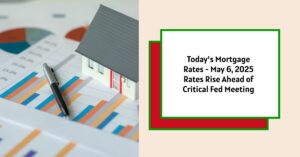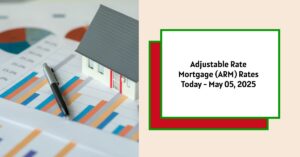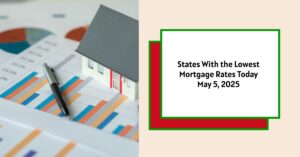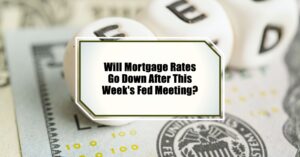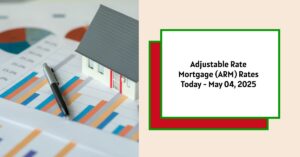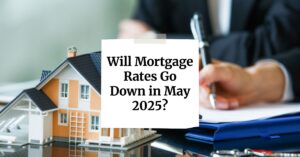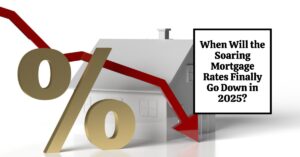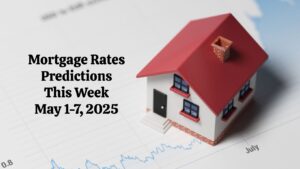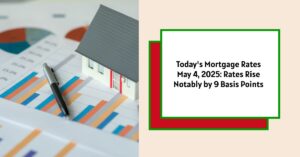As of May 6, 2025, mortgage rates have seen a slight increase compared to recent weeks, reflecting economic conditions and Federal Reserve actions. The 30-year fixed mortgage rate is currently at 6.75%, while the 15-year fixed mortgage rate stands at 5.99%. Homebuyers and homeowners considering refinancing should be aware of these fluctuations, as they significantly impact affordability and overall financial planning.
Today's Mortgage Rates – May 6, 2025: Rates Rise Ahead of Critical Fed Meeting
Key Takeaways:
- 30-year fixed mortgage rate: Increased to 6.75%.
- 15-year fixed mortgage rate: Increased to 5.99%.
- Refinance rates: Averages are higher, with the 30-year refinance rate at 6.81%.
- Economic outlook: Rates may remain elevated as the Federal Reserve approaches its next meeting.
Current Mortgage Rates Overview
Mortgage rates play a crucial role in the housing market's dynamics. They affect how much you'll pay for a home each month, which can determine whether buying a home is feasible for many individuals. The most recent data indicates a trend upwards in mortgage and refinancing rates, attributable to various economic pressures.
| Type of Mortgage | Current Rate |
|---|---|
| 30-Year Fixed | 6.75% |
| 15-Year Fixed | 5.99% |
| 20-Year Fixed | 6.41% |
| 5/1 Adjustable Rate (ARM) | 7.34% |
| 7/1 Adjustable Rate (ARM) | 7.38% |
| 30-Year VA | 6.28% |
| 15-Year VA | 5.87% |
| 5/1 VA Adjustable Rate | 6.48% |
Source: Zillow
These rising rates are occurring while the housing market is already experiencing peak buying season, which makes the cost of homeownership a concern for many buyers. With rates inching upward, the affordability of homes can become strained, especially for first-time buyers or those with tight budgets.
Understanding Mortgages
When evaluating mortgage options, it’s vital to understand the distinctions between fixed-rate and adjustable-rate mortgages (ARMs).
Fixed-rate Mortgages:
- Security and Predictability: These loans maintain a consistent interest rate throughout the entire loan term, which can be particularly advantageous if rates continue to rise.
- Long-term Planning: Borrowers can confidently budget for their monthly payments without worrying that their rate will increase. This can ease planning for family expenses and long-term financial goals.
Adjustable-rate Mortgages (ARMs):
- Initial Lower Rates: ARMs often start with lower rates than fixed-rate loans, making them attractive for those who might only need the loan for a short period.
- Potential for Rate Increase: After the initial fixed period (usually 5, 7, or 10 years), the interest rate adjusts based on market conditions, which can lead to higher payments. This aspect can be risky if rate adjustments occur during an economic downturn, potentially resulting in unaffordable payments.
A Closer Look at Refinance Rates
Refinancing can be an appealing option for many homeowners looking to lower their monthly payments or consolidate other debts. However, recent data indicate that refinance rates have also increased, showing patterns that differ from purchasing rates.
| Type of Refinance | Current Rate |
|---|---|
| 30-Year Fixed | 6.81% |
| 15-Year Fixed | 6.01% |
| 20-Year Fixed | 6.41% |
| 5/1 ARM | 7.34% |
| 7/1 ARM | 7.38% |
| 30-Year VA | 6.28% |
| 15-Year VA | 5.87% |
| 5/1 VA ARM | 6.48% |
Source: Zillow
This increase indicates that although some homeowners may seek to refinance to secure better rates, they must be cautious and thoroughly analyze whether the costs of refinancing (such as closing costs and fees) outweigh the potential benefits of lower monthly payments.
Factors Influencing Today's Rates
Numerous factors contribute to the current mortgage rates, but the interplay between the economy and Federal Reserve policies remains paramount. The Fed’s monetary policy decisions directly influence borrowing costs.
Recent upward turns in tariffs and inflation have created uncertainty in the financial markets, pushing rates upwards. For instance, tariffs introduced on imports are anticipated to raise consumer prices, impacting overall inflation levels. As inflation rises, the Fed may be less inclined to lower interest rates, which further influences mortgage rates.
Interest Rate Examples
Understanding the impact of mortgage rates can best be appreciated through examples. Consider a $400,000 mortgage with different terms:
- 30-Year Fixed Mortgage at 6.75%:
- Monthly Payment: Approximately $2,594.
- Total Interest Paid Over 30 Years: Roughly $533,981.
- 15-Year Fixed Mortgage at 5.99%:
- Monthly Payment: Approximately $3,373.
- Total Interest Paid Over 15 Years: Roughly $207,188.
These calculations illustrate how opting for a shorter-term loan can lead to significant interest savings in the long run. While higher monthly payments for a 15-year mortgage may pose challenges, they can ultimately save borrowers substantial sums in interest paid.
Moreover, many homeowners may consider making additional payments on their 30-year mortgages to effectively shorten their loan duration without committing to the higher monthly payment of a 15-year mortgage. This approach can provide flexibility while still enabling them to pay down their principal faster.
Read More:
Mortgage Rates Trends as of May 5, 2025
When Will the Soaring Mortgage Rates Finally Go Down in 2025?
Looking Ahead
The current economic climate indicates that rates may continue to rise or stabilize without significant changes from the Federal Reserve. Economic analysts are closely watching the upcoming Fed meeting and its potential implications. The consensus is that drastic changes to rates are unlikely, particularly if the Fed seeks to counter rising inflation without disrupting economic growth.
According to Fannie Mae, mortgage rates are expected to end 2025 and 2026 at 6.2 percent and 6.0 percent, respectively, down from 6.3 and 6.2 percent in their prior forecast. While the growth outlook has softened, ESR Group expects the upward pressure on price measures from tariff dynamics may lead to the Federal Reserve taking a wait-and-see approach as it seeks to balance its dual mandate for full employment and price stability.
Projections for future rate adjustments suggest that a cut may be on the horizon later in the year, particularly during summer. If the Fed does respond proactively to incoming economic data, it could create an opportunity for mortgage rates to decrease slightly. Nevertheless, these decisions hinge on broader economic trends, including consumer confidence, job growth, and the impact of external factors like tariffs.
It’s also essential to acknowledge the broader housing market dynamics, particularly for first-time buyers. Many are feeling increased pressure due to rising rates, which can make home buying feel less attainable. The combination of higher interest costs and rising home prices may present significant barriers, making it critical for prospective buyers to evaluate their financial circumstances carefully.
Summary:
Overall, the mortgage and refinance markets as of May 6, 2025, reflect a slight increase in rates due to economic pressures, particularly inflation brought on by tariffs. These shifts affect how affordable obtaining a mortgage is for many individuals looking to buy homes during a peak season. As the Federal Reserve navigates its monetary policy, individuals seeking homes or refinancing should stay informed about shifting rates.
Turnkey Real Estate Investment With Norada
Investing in real estate can help you secure consistent returns with fluctuating mortgage rates.
Despite softer demand, smart investors are locking in properties now while competition is lower and rental returns remain strong.
HOT NEW LISTINGS JUST ADDED!
Speak with an investment counselor (No Obligation):
(800) 611-3060
Also Read:
- Will Mortgage Rates Go Down in 2025: Morgan Stanley's Forecast
- Expect High Mortgage Rates Until 2026: Fannie Mae's 2-Year Forecast
- Mortgage Rate Predictions 2025 from 4 Leading Housing Experts
- Mortgage Rates Forecast for the Next 3 Years: 2025 to 2027
- 30-Year Mortgage Rate Forecast for the Next 5 Years
- 15-Year Mortgage Rate Forecast for the Next 5 Years
- Why Are Mortgage Rates Going Up in 2025: Will Rates Drop?
- Why Are Mortgage Rates So High and Predictions for 2025
- Will Mortgage Rates Ever Be 3% Again in the Future?
- Mortgage Rates Predictions for Next 2 Years
- Mortgage Rate Predictions for Next 5 Years
- Mortgage Rate Predictions: Why 2% and 3% Rates are Out of Reach
- How Lower Mortgage Rates Can Save You Thousands?
- How to Get a Low Mortgage Interest Rate?
- Will Mortgage Rates Ever Be 4% Again?
